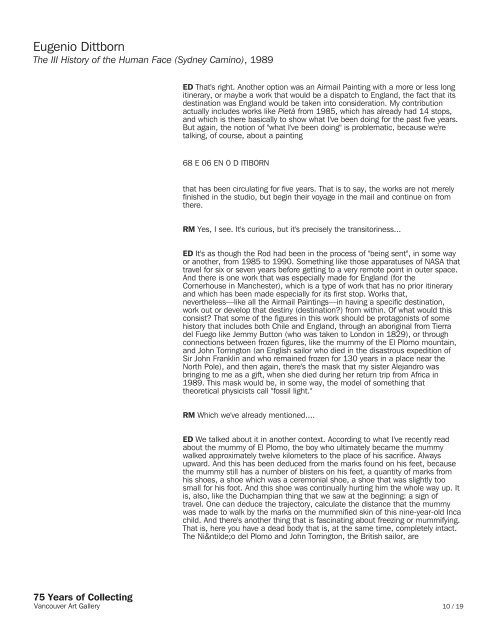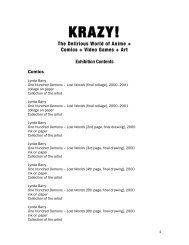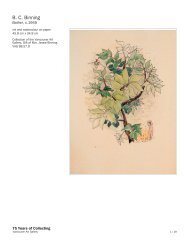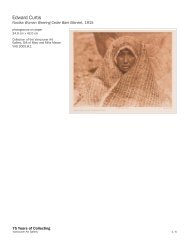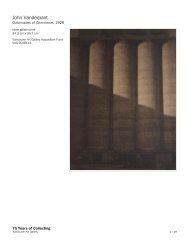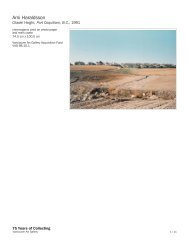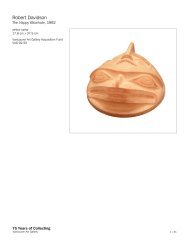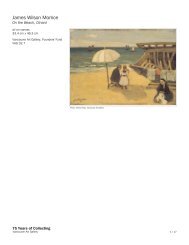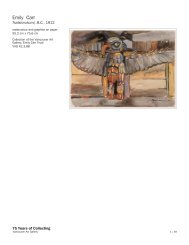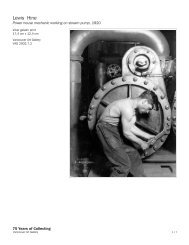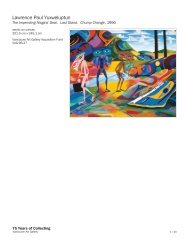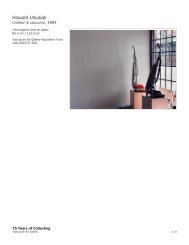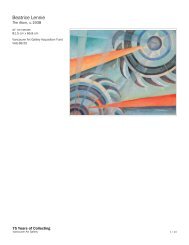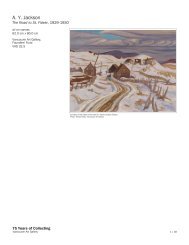Eugenio Dittborn - 75 Years of Collecting - Vancouver Art Gallery
Eugenio Dittborn - 75 Years of Collecting - Vancouver Art Gallery
Eugenio Dittborn - 75 Years of Collecting - Vancouver Art Gallery
You also want an ePaper? Increase the reach of your titles
YUMPU automatically turns print PDFs into web optimized ePapers that Google loves.
<strong>Eugenio</strong> <strong>Dittborn</strong><br />
The III History <strong>of</strong> the Human Face (Sydney Camino), 1989<br />
<strong>75</strong> <strong>Years</strong> <strong>of</strong> <strong>Collecting</strong><br />
<strong>Vancouver</strong> <strong>Art</strong> <strong>Gallery</strong><br />
ED That's right. Another option was an Airmail Painting with a more or less long<br />
itinerary, or maybe a work that would be a dispatch to England, the fact that its<br />
destination was England would be taken into consideration. My contribution<br />
actually includes works like Pietà from 1985, which has already had 14 stops,<br />
and which is there basically to show what I've been doing for the past five years.<br />
But again, the notion <strong>of</strong> "what I've been doing" is problematic, because we're<br />
talking, <strong>of</strong> course, about a painting<br />
68 E 06 EN 0 D ITIBORN<br />
that has been circulating for five years. That is to say, the works are not merely<br />
finished in the studio, but begin their voyage in the mail and continue on from<br />
there.<br />
RM Yes, I see. It's curious, but it's precisely the transitoriness...<br />
ED It's as though the Rod had been in the process <strong>of</strong> "being sent", in some way<br />
or another, from 1985 to 1990. Something like those apparatuses <strong>of</strong> NASA that<br />
travel for six or seven years before getting to a very remote point in outer space.<br />
And there is one work that was especially made for England (for the<br />
Cornerhouse in Manchester), which is a type <strong>of</strong> work that has no prior itinerary<br />
and which has been made especially for its first stop. Works that,<br />
nevertheless—like all the Airmail Paintings—in having a specific destination,<br />
work out or develop that destiny (destination?) from within. Of what would this<br />
consist? That some <strong>of</strong> the figures in this work should be protagonists <strong>of</strong> some<br />
history that includes both Chile and England, through an aboriginal from Tierra<br />
del Fuego like Jemmy Button (who was taken to London in 1829), or through<br />
connections between frozen figures, like the mummy <strong>of</strong> the El Plomo mountain,<br />
and John Torrington (an English sailor who died in the disastrous expedition <strong>of</strong><br />
Sir John Franklin and who remained frozen for 130 years in a place near the<br />
North Pole), and then again, there's the mask that my sister Alejandro was<br />
bringing to me as a gift, when she died during her return trip from Africa in<br />
1989. This mask would be, in some way, the model <strong>of</strong> something that<br />
theoretical physicists call "fossil light."<br />
RM Which we've already mentioned....<br />
ED We talked about it in another context. According to what I've recently read<br />
about the mummy <strong>of</strong> El Plomo, the boy who ultimately became the mummy<br />
walked approximately twelve kilometers to the place <strong>of</strong> his sacrifice. Always<br />
upward. And this has been deduced from the marks found on his feet, because<br />
the mummy still has a number <strong>of</strong> blisters on his feet, a quantity <strong>of</strong> marks from<br />
his shoes, a shoe which was a ceremonial shoe, a shoe that was slightly too<br />
small for his foot. And this shoe was continually hurting him the whole way up. It<br />
is, also, like the Duchampian thing that we saw at the beginning: a sign <strong>of</strong><br />
travel. One can deduce the trajectory, calculate the distance that the mummy<br />
was made to walk by the marks on the mummified skin <strong>of</strong> this nine-year-old Inca<br />
child. And there's another thing that is fascinating about freezing or mummifying.<br />
That is, here you have a dead body that is, at the same time, completely intact.<br />
The Niño del Plomo and John Torrington, the British sailor, are<br />
10 / 19


